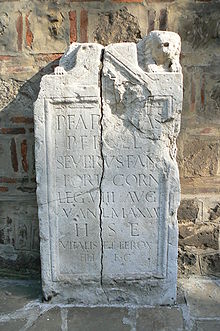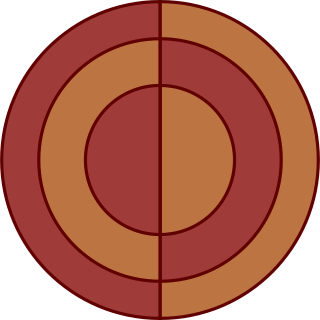


Legio VIII Augusta ("Augustus' Eighth Legion") was one of the oldest legions of the Imperial Roman army. [1]



Legio VIII Augusta ("Augustus' Eighth Legion") was one of the oldest legions of the Imperial Roman army. [1]
They were ordered to Cisalpine Gaul around 58 BC by Julius Caesar and marched with him throughout the entirety of the Gallic Wars, especially during the battles of Gergovie and Alesia. During the war the legion won the title "Gallica." It also earned a reputation for courage. [2]
They stood with him at the Battle of Pharsalus. The legion was also present in Egypt, when Caesar captured Egypt for Cleopatra. In 46 BC, it took part in the Battle of Thapsus near what is now Bakalta, Tunisia shortly before their disbandment.
In 44 BC, Octavian reconstituted the legion that had helped him attain the control of the Roman Empire. In 43 BC it took part in the siege of the Battle of Mutina (current Modena) by Marc Antony, defended by the troops of Decimus Brutus, which earned Legio VIII Gallica the nickname "Mutinensis". [3]

In or before 9 AD the legion was transferred to Poetovium (modern Ptuj). The legion must have won a victory around this time that earned them the cognomen Augusta. At least a detachment also stayed in Burnum, Illyricum where their stamped tiles have been found. [4]
Around 45 under Nero, the VIII Augusta took part in the suppression of the Thracian uprising, [5] and founded its castrum at Novae where the Danube has its most southern bend and from where the legion controlled a long section of the river. [6]
The legion received the title "BIS AUGUSTA" (twice August) for their actions in Thrace. After Nero's death in 69 it gave up this title and in the confusion of the Year of the Four Emperors, the legion voted for Otho and sent a detachment of 2000 men to Italy (as did the 7th and the 3rd legions). [7] Soon after Otho's death, the Danube legions voted for Vespasian and went with him to Mirebeau-sur-Bèze in Gaul [8] where it built its new base in 70 to oppose the revolts of the Treveri and especially the Ubii and Lingones against Rome. [9] [10]
After restoration of Rome`s rule in the North in or before 86, the legion moved to its new headquarters at Argentoratum in Germania Superior (now Strasbourg), where the main part of the unit was stationed until the 5th century.
The legion also fought the Parthian Empire with Septimius Severus, who ruled from 193 until 211, and with his successors.
Records indicate that they were still active during the first years of the fourth century at the Rhine frontier. This means that the history of the legion covers more than 400 years of almost continuous service. In 371 it was again stationed in Argentoratum, according to an inscription. Later, the Roman general Stilicho, was compelled to move the German legions back to Italy to defend it against the Visigothic invasion.
According to Notitia Dignitatum , around 420 an Octaviani unit was under the Magister Peditum of Italia; it is possible that this unit was the old VIII Augusta, which was originally a comitatensis unit but had been promoted to palatina status.
| Name | Position | Year | Location | Reference |
|---|---|---|---|---|
| Numisius Lupus | legatus legionis | 69 | Germania | Tacitus, Histories, III.10 |
| Lucius Antistius Rusticus | legatus legionis | 79/81 | Germania | |
| Marcus Acilius Priscus Egrilius Plarianus | legatus legionis | c. 120 | Germania | CIL XIV, 155, CIL XIV, 4444 |
| Lucius Varus Ambibulus [11] | legatus legionis | c. 162 | Germania | CIL X, 3872 |
| Marcus Juventius Caesianus [12] | legatus legionis | c. 186 | Germania | |
| Publius Aelianus Coeranus [12] | legatus legionis | 221/223? | Germania | CIL XIV, 03586 |
| Aulus Egnatius Proculus [12] | legatus legionis | 190/235 | Germania | CIL XII, 03163 |
| Gnaeus Petronius Probatus Junior Justus [12] | legatus legionis | c. 234 | Germania | CIL X, 1254 |
| Quintus Petronius Melior | legatus legionis | 3rd century | Germania | CIL XI, 3367 |
| Lucius Coiedius Candidus | tribunus laticlavius | before 55 | Germania | CIL XI, 6163 |
| Sextus Sentius Caecilianus | tribunus laticlavius | c. 65 | Germania | CIL IX, 4194 = ILS 8969 |
| Lucius Aemilius Carus | tribunus laticlavius | c. 125 | Germania | CIL VI, 1333 |
| Lucius Neratius Proculus | tribunus laticlavius | c. 128 | Germania | CIL IX, 2457 = ILS 1076 |
| Lucius Cestius Gallus | tribunus laticlavius | between 150 and 175 | Germania | CIL X, 3722 |
| Titus Vettius Deciminus [13] | veteranus legionis | early 3rd century | CIL XIII, 1903 |
- ri[…] G̣allorum tribunus militum legionis VIII Augustae. Cohort of Gauls, military [tribune] of the Eighth Legion Augusta. Brougham ( Brocavum ). CIL VII 300 = RIB 782.

Legio II Augusta was a legion of the Imperial Roman army that was founded during the late Roman republic. Its emblems were the Capricornus, Pegasus, and Mars. It may have taken the name "Augusta" from a victory or reorganization that occurred during the reign of Augustus.

Legio XIV Gemina was a legion of the Imperial Roman army, levied by Julius Caesar in 57 BC. The cognomen Gemina (Twinned) was added when the legion was combined with another understrength legion after the Battle of Actium. The cognomen Martia Victrix was added following their service in the Pannonian War c. AD 9 and the defeat of Boudicca in AD 61. The emblem of the legion was the Capricorn, as with many of the legions levied by Caesar.

Legio XII Fulminata, also known as Paterna, Victrix, Antiqua, Certa Constans, and Galliena, was a legion of the Imperial Roman army. It was originally levied by Julius Caesar in 58 BC, and the legion accompanied him during the Gallic Wars until 49 BC. The unit was still guarding the Euphrates River crossing near Melitene at the beginning of the 5th century.

Legio I Italica was a legion of the Imperial Roman army founded by emperor Nero on September 22, 66. Originally named Legio Phalanx Alexandri Magni, it was stationed in Italy during the year of four emperors and gained the name Italica. It was later stationed at Novae, near modern-day Svishtov (Bulgaria). There are still records of the I Italica on the Danube border at the beginning of the 5th century. The emblem of the legion was a boar.

The Revolt of the Batavi took place in the Roman province of Germania Inferior between AD 69 and 70. It was an uprising against the Roman Empire started by the Batavi, a small but militarily powerful Germanic tribe that inhabited Batavia, on the delta of the river Rhine. They were soon joined by the Celtic tribes from Gallia Belgica and some Germanic tribes.

Legio X Gemina, was a legion of the Imperial Roman army. It was one of the four legions used by Julius Caesar in 58 BC, for his invasion of Gaul. There are still records of the X Gemina in Vienna in the beginning of the 5th century. The legion symbol was a bull. Early on in its history, the legion was called X Equestris (mounted), because Caesar once used the legionaries as cavalry.

Legio XIII Gemina, in English the 13th Twin Legion was a legion of the Imperial Roman army. It was one of Julius Caesar's key units in Gaul and in the civil war, and was the legion with which he crossed the Rubicon in January, perhaps the 10th, 49 BC. The legion appears to have still been in existence in the 5th century AD. Its symbol was the lion.

Legio III Cyrenaica, was a legion of the Imperial Roman army. The legion had its origins among the forces of Mark Antony during the civil wars of late first century BC. In the Imperial period it was stationed in Egypt, where it played a key role in campaigns against the Nubians and Jews. In the first century AD, it was usually located in Arabia Petraea. There are still records of the legion in Syria at the beginning of the 5th century. The legion symbol is unknown.

Legio III Gallica was a legion of the Imperial Roman army. The cognomen Gallica suggests that its earliest recruits came from veterans of the Gallic legions of Gaius Julius Caesar, a supposition supported by its emblem, a bull, a symbol associated with Caesar. The legion was based for most of its existence at Raphanea, Roman Syria, and was still active in Egypt in the early 4th century.

Legio IV Scythica, also written as Legio IIII Scythica, was a legion of the Imperial Roman army founded in c. 42 BCE by the Roman general Mark Antony, for his campaign against the Parthian Empire, hence its other cognomen, Parthica. The legion was still active in the Roman province of Syria in the early 5th century.

Novae was initially one of the few great Roman legionary fortresses along the empire's border, forming part of the defences along the Danube in northern Bulgaria. The settlement later expanded into a town in the Roman province of Moesia Inferior, later Moesia Secunda.

Argentoratum or Argentorate was the ancient name of the city of Strasbourg. The name was first mentioned in 12 BC, when it was a Roman military outpost established by Nero Claudius Drusus. From 90 AD the Legio VIII Augusta was permanently stationed there.

Legio X Fretensis was a legion of the Imperial Roman army. It was founded by the young Gaius Octavius in 41/40 BC to fight during the period of civil war that started the dissolution of the Roman Republic. X Fretensis is then recorded to have existed at least until the 410s.

Legio V Macedonica was a Roman legion. It was probably originally levied in 43 BC by consul Gaius Vibius Pansa Caetronianus and Gaius Julius Caesar Octavianus. It was based in the Balkan provinces of Macedonia, Moesia and Dacia. In the Notitia Dignitatum records from beginning of the fifth century, the legion was still stationed in Dacia, with detachments stationed in the east and Egypt.

The Legio I Maximiana was a comitatensis Roman legion, probably created by Emperor Diocletian in 296 or 297 AD. The legion was named after Maximianus, a colleague of Diocletian. The I Maximiana was formed together with II Flavia Constantia, to garrison the newly created province Thebaidos, in Aegyptus. As well as protect it from neighboring tribes. Since no Legio I Maximiana is listed as being stationed at Thebes in the Notitia Dignitatum, the designation is interpreted more broadly as of the Thebaid in general. The legion is also known as Maximiana Thebanorum or Thebaeorum. The cognomen Maximiana originated from Maximian, Diocletian's colleague.

Legio VI Ferrata was a legion of the Imperial Roman army. In 30 BC it became part of the emperor Augustus's standing army. It continued in existence into the 4th century. A Legio VI fought in the Roman Republican civil wars of the 40s and 30s BC. Sent to garrison the province of Judaea, it remained there for the next two centuries.

Legio XI Claudia was a legion of the Imperial Roman army. The legion was levied by Julius Caesar for his campaign against the Nervii. XI Claudia dates back to the two legions recruited by Julius Caesar to invade Gallia in 58 BC, and it existed at least until the early 5th century, guarding lower Danube in Durostorum.

Mirebeau-sur-Bèze is a commune in the Côte-d'Or department in eastern France.
The Legio IV Italica was a legion of the Imperial Roman army raised in AD 231 by emperor Alexander Severus. The legion remained in existence as late as AD 400.